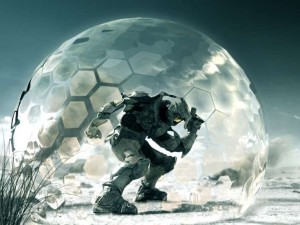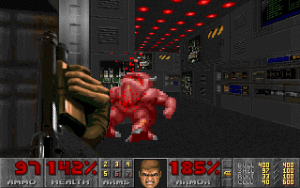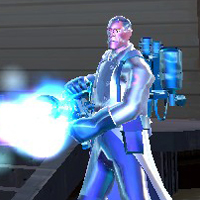 Ah Peter… I see you like making a statement. Awesome, this blog is a mix of all our opinions, and you’ve done a good job of backing up your own point of view. I’m not particularly suprised about your reaction to Halo’s health mechanics though… You’re an old-school online gamer, forged in the searing online fires of Mount Quake.
Ah Peter… I see you like making a statement. Awesome, this blog is a mix of all our opinions, and you’ve done a good job of backing up your own point of view. I’m not particularly suprised about your reaction to Halo’s health mechanics though… You’re an old-school online gamer, forged in the searing online fires of Mount Quake.
In contrast, as I’ve stated before, I like to play shooters (starting with Doom and its awesome shotgun) balls-out fearless, working out interesting ways to leap into the fray and rely on guts and skill to get the job done. Sure I like sessions of strategy too, but there are times where I just enjoy acting like a hero and being rewarded as such. I don’t even mind getting mowed down in tragic fashion if it’s due to my bravado. Such an approach does play havoc with my survivability in certain online contests (notably against Mr. Carlson), but I have fun doing it nonetheless.
The classic 100% health model, however, played a bit at odds with my play style. For me, each room or area of Doom is a fairly self-contained challenge, but upon completion I might have lower health than is practical to move onto the next session and still survive… you can’t always rely on the placement of health kits to get you back up to snuff. I’d often load up a save and try to get through that area with more health. This honed my skill and let me practice new ways of clearing a room, but as time went on, I found myself starting to play the game very “safe”… luring enemies around corners, slowly harassing opponents and so on. Doom suddenly became a very slow game to me. I enjoy tactical exercises like Rainbow Six as much as the next guy, but it wasn’t what I was looking for in a classic action shooter.
 In 2001, however, that changed with Halo. By introducing shields that recharged once you remove yourself from immediate danger, it made my starting point for each challenge roughly the same. Suddenly, I could be heroic, and as long as I persevered, all was forgiven. Even sudden sneak attacks, where an enemy crammed into some unknowable corner got the drop on me, could be survived without excessive aggravation. I didn’t have to rely on reloads to teach me about each room. I still was “rated” on my progress by how much of my valuable ammo I used up, but by being encouraged to switch weapons on the battlefield quickly, I felt continuously propelled forward, ready to take the next challenge fully replenished.
In 2001, however, that changed with Halo. By introducing shields that recharged once you remove yourself from immediate danger, it made my starting point for each challenge roughly the same. Suddenly, I could be heroic, and as long as I persevered, all was forgiven. Even sudden sneak attacks, where an enemy crammed into some unknowable corner got the drop on me, could be survived without excessive aggravation. I didn’t have to rely on reloads to teach me about each room. I still was “rated” on my progress by how much of my valuable ammo I used up, but by being encouraged to switch weapons on the battlefield quickly, I felt continuously propelled forward, ready to take the next challenge fully replenished.
I would have thought Bungie’s reinvention of the classic health system to be one of the most shrewd, calculated design choices in recent history, but I am told that it was a bit more accidental, borne of the sci-fi setting and the expectations of having a “force field”. This is evidenced by the fact that Halo 1 still had non-regenerating “health” under all those shields, replenished at an incredibly stingy pace. Halo 2 ditched all that and went for a straight regen model, ditching “classic” health altogether and cementing regen as something of an industry-standard model, like WASD and Half-Life’s “directional damage” HUD.
 Other shooters adopted health regen in the meantime, like Call of Duty 2, Gears of War, and Blacksite: Area 51. Aside from the pacing differences, it was attractive because it eliminated the need to litter a battlefield with artificial constructs like easily-visible health packs (or worse yet, “food”). One would argue (Peter included) that surviving hundreds of bullets without tangible aid is unrealistic, but the regen model moves the issue behind the scenes, making the immersion a little bit stronger. In addition, health regen has invented a way to take a whole meter off the game interface, helping push forward a new generation of minimal-to-no-HUD games.
Other shooters adopted health regen in the meantime, like Call of Duty 2, Gears of War, and Blacksite: Area 51. Aside from the pacing differences, it was attractive because it eliminated the need to litter a battlefield with artificial constructs like easily-visible health packs (or worse yet, “food”). One would argue (Peter included) that surviving hundreds of bullets without tangible aid is unrealistic, but the regen model moves the issue behind the scenes, making the immersion a little bit stronger. In addition, health regen has invented a way to take a whole meter off the game interface, helping push forward a new generation of minimal-to-no-HUD games.
I certainly don’t consider the regen health model to be a panacea for all games. Multiplayer games have awesomely tense moments when one individual is reduced to low health and must either tough it out (e.g. in Counterstrike) or find a location or teammate to get healed up (e.g. in Team Fortress 2). You might consider it a bold evolution in shooters, but at minimum I don’t think anyone can argue that it’s not a great new tool for game designers to have in their gameplay toolbox.
Well, there’s my opinion. It’s ironic that I’m defending Halo since I’m not a particularly big fan of it… The second half of the first one was a slog for me, and Halo 2 seemed jumbled and punishing. I haven’t picked up the third one yet, so after I finish Bioshock (which will be after I get my poor, broken Xbox back from Microsoft) I’ll check it out. Perhaps we can get a post from a die-hard Halo fan, like Dan O?
[Ed: Check out Peter’s preceding article here.]

I certainly don’t believe that health regeneration is worthless, and I think it could be used to great effect in many situations. I won’t agree, however, that it supports the dramatic high-energy play style that we both enjoy as it is implemented in Halo 3. Both Pat and myself have a similar desire for “kicking ass” action pacing. I think, however, that we’ve overlooked in our two posts what is probably the best health model for our particular cravings. Rick actually brought this up in a reply to my post where he talks about Stranglehold and I discuss it further in talking about PainKiller. I’m not sure how to link to that discussion, so I’ll re-post what I said:
“. . . What happens is, after you kill an enemy their corpse dissipates, leaving a “soul†behind. Collecting these souls replenishes your health. So, there are two important things going on here. The first is that I gain health by killing things so if I’m on a streak I get to keep going nonstop and the second is that the health drops where the bodies fell, so I am encouraged to run headlong into the fight because I won’t get the health if I hang back and take potshots. Now that I think about it, I LOVE this model. . . This approach really addresses a lot of the problems I have with both the shield system and the ‘healh crate’ system.”
I was just chatting with my wife and she started on a Halo tirade, much more vehement than my post, I assure you 🙂 Anyway, she holds up the health system in God of War as one of her favorites. The things she likes are: 1) your health bar is pretty big. You can get hit as many times as about 7 or 8 Halo full shields’ worth before you die. 2) She likes having access to the health chests that will fully replenish you, and using them strategically. Finally, and this is the part that I think is really cool, God of War gives you the opportunity to kill enemies in a way that is more difficult (i.e. finishing moves) in order to milk them for health. The player can decide when he feels like he’s getting low on health and can then change his play style to remedy that. He doesn’t have to hide and he doesn’t have to skulk around looking desperately for a health pack, he just has to kill that minotaur by shoving a blade down its throat rather than simply stabbing it to death. It’s similar to the Painkiller system since the health reward is buried in the game play itself, which is what I think I find really rewarding and it also gives you the “shield reset” at important checkpoints by replenishing you with health chests. Rock on, God of War, rock on.
1. I don’t see how a regen shield is any less realistic than a “health pack” or “med kit” that instantaneously heals the player.
2. Doom is a terrible game, you can’t aim up or down, nuff’ said. (check out Marathon if you want to see a GOOD game that was out at the same time as Doom. P.S. Marathon is made by Bungie and is the kick ass predecessor to Halo.
3. Halo 3 on Xbox Live would be incredible, except that I am a hard core gamer and:
Halo 3 Network Architecture Makes Pro Gaming Impossible
Today I read someone’s blog that said how impressed they were with the amount of information (kills, deaths, ranking) that Halo 3’s game servers stored. I just had to point some things out to him:
1. Halo 3’s game servers don’t store stats. (Their SQL servers do 🙂
2. Halo 3 doesn’t even have game servers. (One of the player’s Xbox is selected as the host).
3, If you play CounterStrike on a Hlstatsx server or a http://www.GetGosu.com server, they store all the info that Halo 3 stores + they store hit box information (besides just tracking head shots they also track legs, arms, chest and also which weapon you used to do all that damage.
4. Because a client machine is acting as the server or host, you can never get a fair game. If you put 8 good players into a game together, the team who has the host on their team will almost always win. That is because the player that is the host has a huge advantage over everyone else. They have a perfect network connection, meanwhile everyone else has to deal with lag. That is simply not fair.
5. Because of this network architecture, you could never ever ever play Halo 3 online in a competitive fashion. Therefore, I suggested to this blogger that if he wanted to play competitively he should get gosu.
I agree that regen allows the player to retain a given fiction and be (probably) be reasonably true to a game’s fiction. Peter’s thoughts on God of War and souls are nice mechanics, although maybe not for every type of setting. Even Gears of War, which doesn’t try to be modern-day, might have been a very strange, less visceral game if there were souls hanging around characters.
The Darkness had something like this mechanic without something a little more tangible than “souls” I think, because you could take the hearts of your downed enemies for energy (now that’s visceral). For some reason it didn’t propel me forward though… I think it was the amount of time it took to do so… you couldn’t eat a heart while in combat, and going back to eat one was tedious as well.
I can’t say I don’t respect games that hold back on regen either. Up until the mid-90’s, most fantasy RPG’s (like Shadowcaster, or Might & Magic, or any D&D-based game) allowed the concept of “resting” to restore mana and health. It really led to a creep-forward-then-rest play pattern. Then along came Diablo, that gave you NONE of that, which frankly struck me like a brick wall. If you were out of mana, you had NO choice but to head back (made easy with limited town portals) and get some mana potions. My initial reaction was “holy shit!”, but I quickly found that it allowed them to grant regen from certain weapons to become part of their economy. Also, they were generous enough with potions (more so than most fantasy games) that the player eventually stopped hoarding them and considered magic to be a matter of managing the potion supply (or by acquiring mana regen items). Health ended up the same way.
Why would I make this point except to undermine the above article? Well, I just wanted to make a point that the health model for any game is a choice in the economics of the game. It also, as I stated above, affects one’s play patterns greatly. Back in the day before game design turned into a true specialty, the design of a game was often arbitrary: if someone played a lot of D&D, you’d see a lot of D&D-like mechanics in their game. Or if everyone was playing the flavor-of-the-month game, it would have a lot of influence in the games under development. Nowadays I’d like to think that designers have enough tools in their belt to consider the game experience and make the numbers work to reinforce the play style they want to encourage in gamers.
I like health regeneration as much as the next guy. When I first experienced in the star wars shooter republic commando and it hit me as so natural that super awesome future commando types had recharging shields. Same with diablo. So I have to drink a small red potion while swinging two giant axes and slaying these demons? No problem. It hindered my enjoyment in call of duty though. So my squad is getting shred to pieces by a tank and I have to get a rocket launcher in ’40 France but when I get hit I only have to duck and catch a deep breath? That is not good for your immersion in the game especially not when the first game was so much fun on hard without the medikits.
I agree that suspension of disbelief is challenged whether you just wait behind a rock to heal or if you pick up a giant white “health box” with a red plus on it.
S’funny, a few years ago a game was challenged for having almost the exact same system… The game was The Getaway, which used the “rest against a wall” model to achieve a completely HUD-less experience. The results weren’t as fun as they should have been, but it’s interesting to see that mechanic under fire in a GTA-style game but not for a shooter.
Again, in the case of that game, it wasn’t that it was 100% realistic, but because they wanted to make the player forget that they were in a game with meters and crap like that. I think it was a noble goal, and worth that leap (again, I just wish the resulting game hit the mark better).
My big problem with the shield mechanic is tied to the fact that I suck at Halo.
When I play MP Halo, I get waxed pretty badly, and what makes it all worse is the shield system.
In a traditional, no-regen shooter, When I get into a blazing firefight and die, I at least die knowing that there has been a battle of attrition, and that I’ve taken a few chunks out of my enemy. When I respawn and face him down again, those chunks will still be gone, and I can finish the job. He will take some chunks out of me in the process, respawn and come finish the job, and so goes the big circle of life in non-regen deathmatches. The one who can lose the fewest chunks in the firefight will get more frags over time, but even when you die, you know it wasn’t totally in vain.
Back to Halo.
I get into a firefight that I inevitably lose, and in the process…reduce my opponent’s shield a bit? The shield regens, I respawn, and the process repeats itself, and I never make a single bit of headway or take out a significant chunk; it’s all for naught.
I don’t mind losing a game to better players, but when I go around constantly feeling like I’ve died without having done anything useful at all, it’s just not fun.